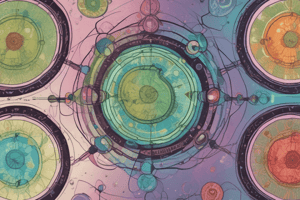Podcast
Questions and Answers
What phase of the cell cycle accounts for 90% of its duration?
What phase of the cell cycle accounts for 90% of its duration?
- Cytokinesis
- M Phase
- Interphase (correct)
- G2 Phase
Which phase of interphase involves DNA replication?
Which phase of interphase involves DNA replication?
- M Phase
- G1 Phase
- S Phase (correct)
- G2 Phase
During which stage of mitosis do sister chromatids get pulled apart?
During which stage of mitosis do sister chromatids get pulled apart?
- Telophase
- Anaphase (correct)
- Metaphase
- Prophase
Which checkpoint ensures DNA has been accurately replicated?
Which checkpoint ensures DNA has been accurately replicated?
Which cell cycle regulation protein is responsible for preventing uncontrolled division?
Which cell cycle regulation protein is responsible for preventing uncontrolled division?
What is the primary outcome of cytokinesis?
What is the primary outcome of cytokinesis?
What phase occurs after mitosis in the cell cycle?
What phase occurs after mitosis in the cell cycle?
Which proteins regulate the progression of the cell cycle?
Which proteins regulate the progression of the cell cycle?
Flashcards are hidden until you start studying
Study Notes
Overview of the Cell Cycle
- The cell cycle is the series of events that lead to cell division and replication.
- It consists of several phases that prepare a cell for division.
Phases of the Cell Cycle
-
Interphase (90% of the cell cycle)
- G1 Phase (Gap 1):
- Cell grows and synthesizes proteins.
- Organelles are duplicated.
- S Phase (Synthesis):
- DNA is replicated.
- Each chromosome now consists of two sister chromatids.
- G2 Phase (Gap 2):
- Cell continues to grow and prepares for mitosis.
- Checks for DNA replication errors.
- G1 Phase (Gap 1):
-
M Phase (Mitosis)
- Division of the nucleus and cytoplasm.
- Stages of Mitosis:
- Prophase: Chromatin condenses into chromosomes; nuclear envelope breaks down.
- Metaphase: Chromosomes align at the cell's equatorial plane.
- Anaphase: Sister chromatids are pulled apart to opposite poles.
- Telophase: Nuclear membranes reform around each set of chromosomes; chromosomes decondense.
-
Cytokinesis
- Division of the cytoplasm, resulting in two daughter cells.
- In animal cells, the cell membrane pinches inwards; in plant cells, a cell plate forms.
Regulation of the Cell Cycle
- Controlled by cell cycle checkpoints to prevent errors:
- G1 Checkpoint: Checks for cell size, nutrients, DNA integrity.
- G2 Checkpoint: Ensures DNA has been replicated correctly.
- M Checkpoint: Confirms chromosome alignment before division.
Cell Cycle Regulation Proteins
- Cyclins: Proteins that regulate the cell cycle; levels fluctuate throughout the cycle.
- Cyclin-dependent kinases (CDKs): Enzymes that, when activated by cyclins, drive the cell through the cycle.
- Tumor suppressor proteins (e.g., p53): Prevent uncontrolled division.
- Oncogenes: Mutated versions of normal genes that can promote cancer when overactive.
Importance of the Cell Cycle
- Essential for growth, development, and tissue repair.
- Dysregulation can lead to uncontrolled cell division, resulting in cancer.
Overview of the Cell Cycle
- Series of events resulting in cell division and replication.
- Comprised of multiple phases that prepare cells for division.
Phases of the Cell Cycle
-
Interphase (accounts for about 90% of the cell cycle):
- G1 Phase (Gap 1):
- Cell growth and protein synthesis occur.
- Duplication of organelles begins.
- S Phase (Synthesis):
- DNA replication takes place.
- Each chromosome is converted into two sister chromatids.
- G2 Phase (Gap 2):
- Further cell growth and preparation for mitosis.
- DNA replication errors are checked for accuracy.
- G1 Phase (Gap 1):
-
M Phase (Mitosis):
- Involves the division of the nucleus and cytoplasm.
- Stages of Mitosis include:
- Prophase: Chromatin condenses into visible chromosomes; nuclear envelope disintegrates.
- Metaphase: Chromosomes align along the equatorial plane of the cell.
- Anaphase: Sister chromatids are separated and move to opposite poles.
- Telophase: Nuclear membranes reform around each chromosomal set; chromatids relax back into chromatin.
-
Cytokinesis:
- Division of the cytoplasm, leading to two daughter cells.
- In animal cells, the cell membrane pinches inward; in plant cells, a cell plate forms to separate the daughter cells.
Regulation of the Cell Cycle
- Cell cycle checkpoints function to prevent errors, ensuring proper division:
- G1 Checkpoint: Evaluates cell size, nutrient availability, and DNA integrity.
- G2 Checkpoint: Confirms accurate DNA replication before mitosis.
- M Checkpoint: Assesses chromosome alignment before division.
Cell Cycle Regulation Proteins
- Cyclins: Proteins regulating the cell cycle, with fluctuating levels throughout the cycle.
- Cyclin-dependent kinases (CDKs): Enzymes activated by cyclins that facilitate progression through the cell cycle.
- Tumor suppressor proteins (e.g., p53): Act to prevent uncontrolled cell division, thereby protecting against cancer.
- Oncogenes: Mutated forms of normal genes that, when overactive, can promote cancerous growth.
Importance of the Cell Cycle
- Crucial for processes such as growth, development, and tissue repair.
- Dysregulation of the cell cycle can lead to uncontrolled cell proliferation, ultimately resulting in cancer.
Studying That Suits You
Use AI to generate personalized quizzes and flashcards to suit your learning preferences.




